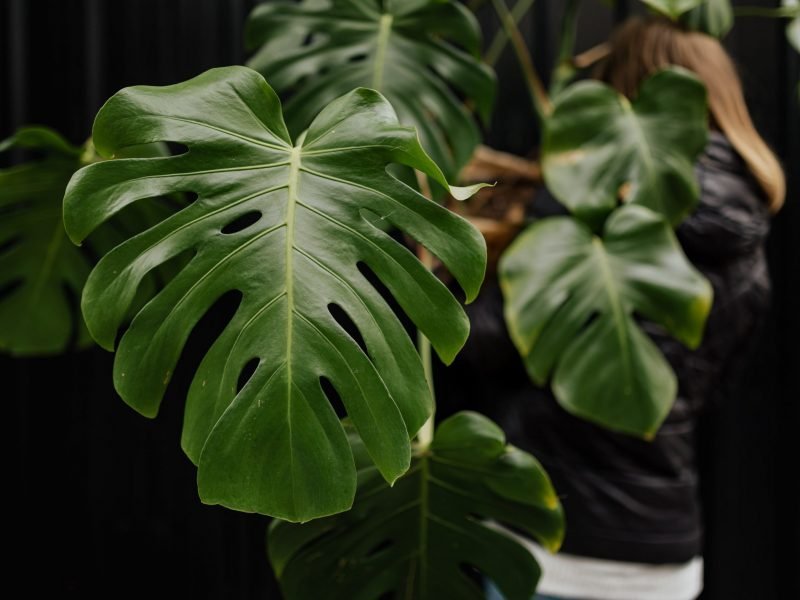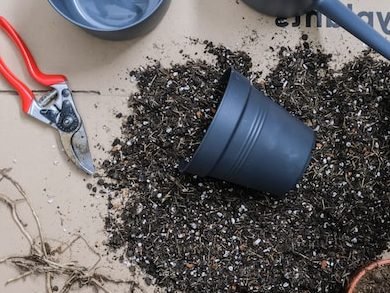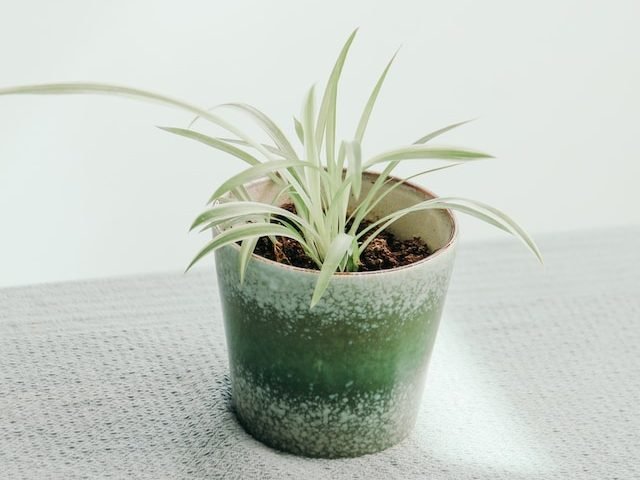
Reigning high on the list of most popular houseplants, Monstera plants are known for their luscious green leaves. But to achieve a good level of strong, large and healthy growth, most of the time you need to supplement the nutrients found in the potting mix with fertilizer (otherwise known as feeding your plant).
Fertilizing the right amount in the right way can lead to much healthier, stronger and faster new growth so is definitely something you want to be incorporating into your Monstera care.
A lot of plant parents find fertilizing any houseplant a little bit terrifying and even more so with Monsteras. This is often because of them being large and expensive so people are more hesitant to play around with their care routine to minimize any damage to their plant.
But fret no longer, because in this article we will cover the do’s and don’ts when it comes to fertilizing your plant to ensure you’re confident in how, why and when to do it.
Why Fertilize your Monstera Plant?
Boost nutrients in the soil
Fertilizing your Monstera is a really easy way to increase the soil quality and boost the number of nutrients in the soil. If you aren’t replacing some of the soil regularly or have used a lower-quality potting mix to start with, then fertilizing can help ensure that your plant is getting what it needs to thrive.
Most of the time you’ll see nitrogen fertilizers as this is one of the key things that your Monstera (and other houseplants) need to thrive and over time the amount of it in the soil can become depleted.
Promote overall plant health and size
By boosting the nutrients in the soil, you’re helping your Monstera to grow stronger and quicker. This can often lead to larger leaves, stronger stems and more vibrant leaves.
Promote flowering
Although it’s rare for Monstera plants, they can occasionally produce white flowers. You’ll see this a lot more in their natural environments but one thing that fertilizer can do is promote the growth of flowers and fruit. This is more the case in other houseplant types that flower more frequently but it can boost growth for Monstera flowers too.
Increasing stress tolerance
Whilst it may seem obvious that a happy and healthy plant is less susceptible to issues, it’s less common knowledge that a healthy strong plant is less susceptible to a pest infestation. Fertilizing can help promote growth but also general health which aids your plant’s defence against pests and disease.
Fertilizer can also help your Monstera adapt a little bit more to different environments (eg. a drop in light level, temperature or humidity). Whilst it won’t keep them from developing issues in very extreme environments, it just helps them be a little bit more adaptable.
When to Fertilize your Monstera Plant
Signs that your Monstera needs fertilizing
Slow or stunted growth is a common sign that your Monstera needs feeding. This is only the case though in the growth period of spring and summer. If your plant isn’t developing any new leaves in winter, then don’t be alarmed as this is common. It’s simply because this is a dormant period for your plant.
Yellow leaves are another potential sign that your plant needs fertilizing. Be careful with this one though because not only can yellow leaves be caused by a whole range of factors (too much light, overwatering) but over-fertilization can also cause them to turn yellow. Make sure to eliminate other potential factors before jumping to the conclusion that you should be fertilizing more
If your Monstera has all of a sudden started to develop small leaves during summer and nothing else in the environment or your care routine has changed, then this indicates a lack of fertilizer. Because your plant has become nutrient deficient, it can’t sustain the same level and size of growth as previously.
Wilting is another one to look out for as a potential indicator. Similarly to yellow leaves, there are also a number of other factors that can cause this but under-fertilization is one of them.
Time of year considerations
This one’s very important, so listen up! If there’s one thing to take away from this article then it needs to be that you should only be fertilizing your Monstera during spring and summer.
Monsteras (and all other houseplants) go into a dormant phase in autumn and winter where they don’t produce much or any growth. In fact, our Monstera never ever produces a leaf for about 6 months of the year.
Because of this, they don’t need to be fertilized as you don’t want to be promoting growth during the dormant phase. If you do fertilize in this period then it can actually be quite damaging to your plant’s health.
Environmental factors to consider
The frustrating thing about fertilizing is that there isn’t really a one fits all routine. On average you should be fertilizing your Monstera once a month. However, light level, temperature, size of your plant and soil moisture retention can all play a part in increasing or decreasing this amount.
If unsure, start by fertilizing the recommended amount of once a month and adjust from there.
When to avoid fertilizing
It’s not just during autumn and winter that you want to avoid fertilizing as there are a few other instances where you should hold off. Firstly, if your Monstera is less than one year old then you shouldn’t be feeding it quite yet. And stay away from fertilizer with any cuttings that you might take as this will often burn the cuttings and make the propagation attempt a failure.
You also want to hold off for a few months if you have recently propagated, pruned or repot your Monstera. These can be quite stressful events for your plant so they need some time to recover before producing an abundance of new growth.
Types of Fertilizer for a Monstera
All-purpose liquid fertilizer
This type of fertilizer is a nice all-rounder suitable for all types and sizes of Monstera plants and is a safe option if you’ve never fed any of your houseplants before. They will mostly contain a well-balance mix of the main nutrients.
Slow-release fertilizer
This type will gradually release nutrients over a period of a few weeks which can help to avoid issues caused by overfertilizing. These often come as pellets that you mix into the soil or as sticks that you push into the top of the pot.
Organic fertilizer
These are made from natural materials and can help improve soil quality and support healthy microbial activity in the soil. For example, compost or worm castings can work really well for Monsteras.
Foliar spray fertilizer
These are a little bit different to traditional fertilizers in that you actually spray them directly onto the leaves. They are often lower in concentration so that it doesn’t burn the leaves.
This means that they can be used more consistently compared to other stronger fertilizers where you don’t want to be feeding more than once a month.
The Best NPK Ratio for Monsteras
You may be wondering what we even mean when it comes to the term NPK ratio. It’s actually quite simple in that it stands for the ratio of nitrogen, phosphorus and potassium in the fertilizer.
The ideal NPK ratio for a Monstera is 5-3-2. This will give a good balance of the key nutrients to promote healthy, strong growth without over-fertilizing.
How to Fertilize your Monstera
Choosing the right fertilizer
If you’ve never fertilized any of your houseplants before, then we recommend choosing a water-soluble liquid fertilizer. The way in which you give it to your Monstera is by mixing it into the water and that’s it – easy!
If you choose to experiment a little with slow-release fertilizers then these are often mixed in with the whole potting mix. To do this you will need to remove your plant from its pot to mix it with the soil. Other slow-release fertilizers come in sticks that you just pop into the soil, it takes seconds!
Dilute your fertilizer properly
When it comes to liquid fertilizer, finding the right level of dilution is key. Unfortunately, it can be different for each brand and type so we recommend reading the instructions and diluting it a little more than what’s on the bottle, to begin with. This will avoid any potential over-fertilizing and you can adjust upwards over the next few months if you want to.
Water your plant before fertilizing
This is a step often forgotten by plant parents but we recommend watering your plant a little bit before and after adding the fertilizer (unless you’re feeding using a liquid fertilizer). Watering before helps prevent the roots from becoming burnt from contact with the fertilizer and watering afterwards helps to distribute it around the soil.
Monitoring your plant
Keeping a close eye on your Monstera in the upcoming weeks will be crucial as you want to spot any signs of distress as quickly as possible. The most common sign that you have over-fertilized are yellow leaves that look quite burnt.
What’s the best fertilizer for a Monstera?
You want to use a well-balanced fertilizer that contains nitrogen, phosphorus and potassium. This will promote stronger and faster growth. You can choose between liquid fertilizer, slow-release pellets or sticks, organic fertilizer or foliar spray.
How often should I fertilize my Monstera?
On average you should be fertilizing your Monstera once every 4 weeks during spring and summer. This can vary a little depending on the size and maturity of your plant as well as environmental factors such as light and temperature.
What happens if I don’t fertilize my Monstera?
Monstera plants can still thrive without fertilizer but growth may be slower and smaller. Fertilizer also helps develop a stronger root system which helps create a strong and stable plant.
Should I add fertilizer to the water or soil for my Monstera?
You can use either a liquid fertilizer in the water or slow-release pellets or sticks that you push into the soil. Both are effective and work well for Monstera plants.
What is the ideal NPK ratio for my Monstera?
The best NPK ratio for a Monstera is 5-3-2 for nitrogen, phosphorus and potassium.
How do I know when my Monstera needs fertilizing?
On average you can be fertilizing your Monstera once a month during spring and summer. However, if your plant is stagnant or growing very small leaves during the growth seasons, then you may need to increase this to every 3 weeks for a few months.
What is the best fertilizer for a Monstera?
Ideally, you want a fertilizer with an NPK of 5-3-2. If you’re unable to find this then a well-balanced liquid fertilizer will work well.
Now you’re pretty much an expert on fertilizing Monstera plants and we hope that you can now confidently feed your plant in the right way, at the right time. The key thing with feeding your plants is doing it in moderation as over-fertilization can be more harmful than not doing it at all sometimes. You can always increase how much you are fertilizing, but it’s hard to take it back without replacing all of the soil.
The other thing that you need to take into consideration when feeding your Monstera is that it won’t have a miracle effect. You won’t all of a sudden see new leaves popping out from the stems, all much larger and more vibrant than the ones before. Monsteras are relatively slow growers and the impact will be gradual but steady. Some of the positive effects you might not be even able to tell (eg. stronger stems and roots). Over time though, with a good feeding routine, you will be rewarded for your efforts.
To learn more about how to care for your plant and keep it happy and healthy, check out our Monstera care guide.















